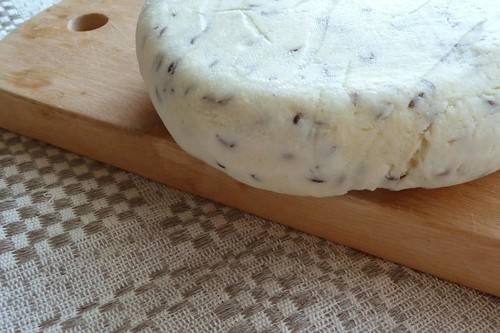Jāņu siers

Līgo vakars is tomorrow and we've been patiently waiting for our kefir biezpiens to finish drying so we could make Jāņu siers (Latvian Solstice caraway cheese) today.
Making this type of fresh cooked cheese is a semi-involved process that takes about an hour of active cooking time. We made a small cheese this year since it's just the two of us but it's great for starting out too.
As far as biezpiens goes, I'm working on solidifying the process for making biezpiens from kefir and will test how to make it from buttermilk. For now, check out the comments on Gateway Cheese and read the Latvian pankūkas post for details on pressing kefir cheese to make a basic biezpiens.
So without further ado.. Let's begin!
Jāņu siers -- Latvian Solstice caraway cheese [printable recipe]
Equipment Needed:
- Dairy thermometer
- Large pot, nonstick if possible
- Deep 8" nonstick skillet
- Wooden spoon (traditional) or silicone/heatproof nonstick spatula
- Finely woven cheesecloth or coarsely woven flour sack towel
- Large colander or sieve
- Large bowl big enough to fit the colander
- Small bowl
- Slotted spoon
- Large cutting board
- Pitcher or storage container for whey
- Two nesting tupperware containers to act as a cheese mold
- Weight
Ingredients:
- 9 ounces (250 g) biezpiens
- 2 quarts milk, preferably whole
- 1 to 1 1/2 cups kefir or buttermilk
- 1 egg plus 1 egg yolk
- 1/2 stick (50 g) butter
- salt to taste
- caraway seeds to taste
Preparing the Curds:
In a large pot over medium-low heat, heat milk until small bubbles start breaking the surface then add the kefir and biezpiens in small crumbles. Stir periodically, keeping the mixture hot but not simmering, around 160F. (I live at a high altitude, so your temps may vary.) Curds will begin to form around the biezpiens.
As the whey begins to clear, keep a close eye on things. It won't take long to go from mostly milk to mostly curds.
Once it's nicely separated, carefully lift out the curds with a slotted spoon into a cheesecloth-lined large colander set in a large bowl. Once you've removed most of the big curds, drain the bowl under the colander into a waiting storage pitcher for future use. Replace the bowl and carefully drain the remaining whey and curds into the colander. Drain the whey left in the bowl into your container. You can use this to make whey ricotta if you like or use it to add flavor in place of water. My husband loves to drink it cold!
You need to press out any remaining whey, so gather up the edges of the cloth and wind up the cloth to help squeeze out some whey. Don't be afraid to just grab on and squeeze too but be careful, it's hot!
Cooking the Curds:
Set the 8" deep skillet on medium-low heat and begin melting the butter.
Move to the cutting board and begin kneading the cloth-covered curds. Some whey will come out but it should be fairly dry by now.
In a small bowl, mix together the egg and egg yolk, along with caraway and salt to taste. You're looking for enough caraway to comfortably speckle the cheese which is probably a couple of tablespoons. Unwrap the cheese and add it, mixing it well with your hands.
Now that the butter is melted, place the caraway cheese in the pan and begin mixing in the butter.
The lower the temperature and the shorter the heating time, the more crumbly the cheese will be. Conversely, the higher the temperature and longer the heating time, the more solid the cheese will be.
Always keep the cheese moving. It will be very crumbly in the beginning.
Moosh it around, fold it, spread it, just keep it moving.
Eventually, it will stop crumbling and start becoming shiny and elastic, much like good bread dough. Keep going.
No, your arm won't fall off.
I hope.
Almost there!
Okay! You made it! Turn off the heat and spread a clean, damp bit of cheesecloth in your container you want to use as a mold. (I used a couple of Tupperware I had laying around.)
Forming the Finished Cheese:
Press the cheese out so it fills the mold nicely then fold over the cloth and drop the other container on top.
Fill it with something heavy. I used river rocks I bought at the local dollar store for a 50c a pound (there's about 6 lbs as shown). This will make your cheese harder.
Leave it out on the counter for a while so it can cool down then you can put it in the fridge to finish. Once it's cooled and had a chance to start forming a hard rind, take it out of the mold, unwrap it, sprinkle some kosher salt all over the cheese and rewrap it before placing it back under the weights in the mold. Don't touch for at least a few hours!
Now, grab one of those beers you have waiting for Jāņi tomorrow. You deserve it!